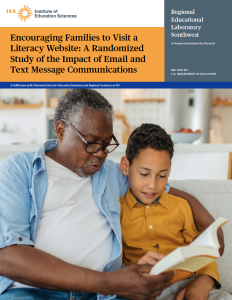
Home
Publications
Encouraging Families to Visit a Literacy Website: A Randomized Study of the Impact of Email and Text Message Communications
Encouraging Families to Visit a Literacy Website: A Randomized Study of the Impact of Email and Text Message Communications
by Candace Hester, Andrew Jaciw, Anja Kurki, Jenna Zacamy, Ashley Pierson, Garrett Lai and Amy Feygin

The Arkansas Department of Education partnered with the Regional Educational Laboratory Southwest to study the feasibility and effectiveness of using brief email and text message communications (called nudges) to increase the number of parent and guardian visits to the Reading Initiative for Student Excellence (R.I.S.E.) state literacy website. In November 2021, the department sent test messages to families to determine the percentage of households with children in kindergarten to grade 6 in Arkansas public schools that had a working email address or cell phone number and whether the percentage differed by school locale (rural or nonrural) or demographic composition (percentage of economically disadvantaged students, Black students or Hispanic students, or English learner students). Subsequently, the department randomly assigned 700 Arkansas public elementary schools to one of eight conditions, which varied the mode of communication (email only or email and text message), the presentation of information (no graphic or with a graphic), and the type of sender (generic sender or known sender). In January 2022, households with children in these schools were sent three rounds of communications with information about literacy and a link to the R.I.S.E. website. The study examined the impact of these communications on whether parents/guardians clicked the link to visit the website (click rate) and conducted an exploratory analysis of differences in how long they spent on the website (time on page).
The study found that nearly all households had a working email address or cell phone number. Households with children in rural schools or schools with higher percentages of economically disadvantaged students were less likely than other households to have a working email address. The percentage of households that had a working cell phone number did not vary by school locale or demographic composition. Nearly one in five households opened at least one email, and nearly 80 percent of households received at least one text message. The click rate was highest among households assigned to receive both emails and text messages with a graphic from a known sender. The higher click rate can be attributed to adding text messages and to sending communications from a known sender. The impact on the click rate was similar for schools in different locales and with different demographic compositions. The Arkansas Department of Education can use the findings to inform decisions about how best to communicate with families about literacy and other evidence-based resources. The findings can also be used by other state and local education agencies to inform decisions about using email or text message communications to share resources with families.
Online Availability
Publication Information
Southwest | Publication Type:
Impact Study | Publication
Date: December 2022



